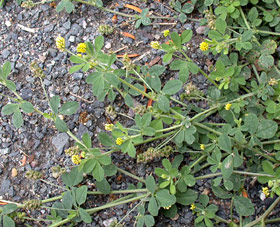Black Medic, Medicago lupulina

UMass Amherst.
IPM Steps to Reduce Black Medic
1. Sample for Pest
Confirm the presence of black medic before you treat.
Where to find it while inspecting: Found in turf and disturbed soils that tend to be dry and nutrient deficient.
2. Proper ID
Is it black medic?
Size and Appearance: Spreading, low stems, branched at base. Leaves are alternate, three to a stem and resemble lawn clover and woodsorrel, (smaller leaflets vary in shape and size), bright yellow flowers with dense flower heads.
3. Learn the Pest Biology
What is the life cycle of black medic?
Life Cycle: Summer annual, reproduces by seed which germinate in spring or fall. Flowers and seed production continue all summer. Yellow flowers eventually become black seedpods when mature.
Preferred habitat: Grows well in dry soil, soil low in nitrogen, compacted soil.
4. Determine Threshold
How much black medic is too much?
Threshold: Because it produces a few thousand seeds in a season, and flower heads grow low to the ground, it is difficult to control once established. Act promptly when you find this plant.
5. Choose Tactics
Creating a healthy soil condition and understanding turfgrass’s needs is the first step in reducing turf pests. What can I do to treat, reduce, or prevent black medic?
Best Management Practices: Black medic can often be removed by hand when soil is moist. Reduce compaction by use of aeration. Give your turfgrass chance to succeed: maintain proper soil pH: 6.0 to 6.8 (test every 3–5 years). Fertilize at the proper time for turfgrass root development, primarily fall (late spring at times when turf is weak and thin), irrigate if needed, mow at proper height (removing no more than 1/2 of the blade), amend poor soil, choose proper turfgrass seed for your conditions, buy quality seed, overseed thin spots in fall or early spring, remove thatch. Remove small patches of black medic by hand-weeding when soil is moist or digging out. Aerate soil to help turfgrass and reduce compaction. Mow at higher end of mowing tolerance range for turfgrass species and cultivars when possible to shade out germinating seeds. In Gardens: does not thrive in shade, so mulch reduces germination and new growth.
Treatment Methods: Black medic will not thrive where turfgrass is given proper moisture and soil is aerated. Where these actions can not succeed, and manual removal is not an option, you may choose to use a herbicide where allowed by law; a general broadleaf herbicide in spot applications.
6. Evaluate
Was the tactic successful? Record the date pests were first noted, and the tactic you used, and its success. Use one of our RECORD KEEPING tools.
For More Information:
Utah State University Extension Weed Guides: Black Medic
Remember:
When a pesticide application is necessary, all necessary and required precautions are taken to minimize risk to people and the environment and to minimize risk of pesticide resistance or pest resurgence. Pesticide use in your school may be prohibited or regulated by local policies or state and federal regulations. Risk reduction methods can include, but are not limited to, spot-treatment, the use of gel or paste bait formulations placed in inaccessible locations, injection into a crack or crevice, and other methods that reduce potential exposure.